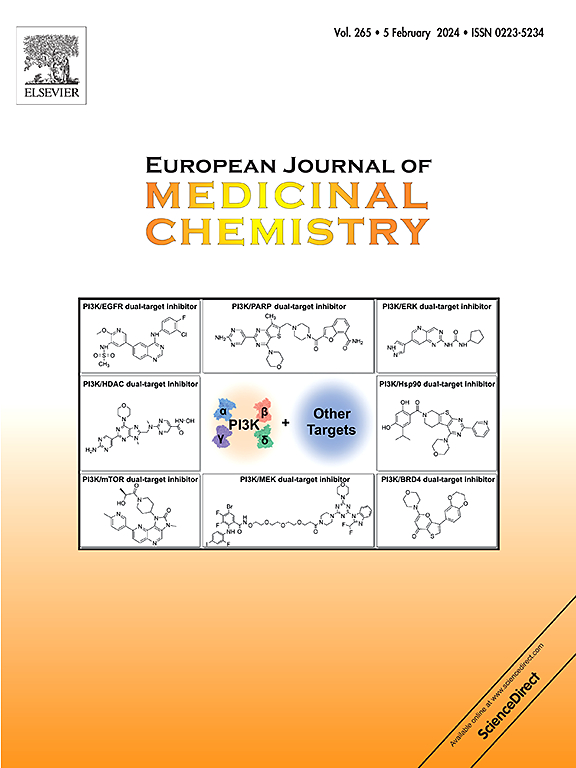肝丙酮酸激酶变构配体的荧光结合试验
IF 6
2区 医学
Q1 CHEMISTRY, MEDICINAL
引用次数: 0
摘要
环境敏感的荧光探针是研究生物系统和推进药物发现不可缺少的工具。本研究报道了基于4-磺胺酰基-7-氨基苯并恶二唑(SBD)的丙酮酸激酶(PKL)肝脏异构体变构位点荧光探针的开发。通过将SBD片段整合到已知的激活剂支架中,如米他伐特和二芳基磺胺(DASA)配体,设计了用于指示剂位移测定的探针,以量化配体在变构位点的相互作用。化合物4a对PKL的结合表现出剂量依赖性的荧光增强,并与未标记的配体mitapivat、TEPP-46、DASA-58和报道的激活剂21进行竞争结合试验。构效关系(SAR)分析揭示了影响活性和荧光灵敏度的关键结构特征。由于结合不受天然配体(如ADP、果糖-1,6-二磷酸(FBP)、磷酸烯醇丙酮酸(PEP)和苯丙氨酸)的影响,探针选择性地报告了变构位点配体。这些发现为检测PKL中的变构配体参与提供了一个实用的框架,并扩展了推进PKL靶向治疗的分子工具库。本文章由计算机程序翻译,如有差异,请以英文原文为准。

Fluorescent binding assay for allosteric ligands of liver pyruvate kinase
Environment-sensitive fluorescent probes are indispensable tools for studying biological systems and advancing drug discovery. This study reports the development of 4-sulfamoyl-7-aminobenzoxadiazole (SBD)-based fluorescent probes for the allosteric site of the liver isoform of pyruvate kinase (PKL). By integrating SBD moieties into known activator scaffolds, such as mitapivat and diarylsulfonamide (DASA) ligands, probes for indicator displacement assays were designed to quantify ligand interactions in the allosteric site. Compound 4a displayed dose-dependent fluorescence enhancement in response to PKL binding and was used in a competitive binding assay with unlabeled ligands: mitapivat, TEPP-46, DASA-58 and reported activator 21. Structure–activity relationship (SAR) analysis revealed key structural features influencing activity and fluorescence sensitivity. The probes report selectively on the allosteric site ligands as the binding was not affected by natural ligands, such as ADP, fructose-1,6-bisphosphate (FBP), phosphoenolpyruvate (PEP), and phenylalanine. These findings provide a practical framework for detecting allosteric ligand engagement in PKL and expand the repertoire of molecular tools for advancing PKL-targeted therapies.
求助全文
通过发布文献求助,成功后即可免费获取论文全文。
去求助
来源期刊
CiteScore
11.70
自引率
9.00%
发文量
863
审稿时长
29 days
期刊介绍:
The European Journal of Medicinal Chemistry is a global journal that publishes studies on all aspects of medicinal chemistry. It provides a medium for publication of original papers and also welcomes critical review papers.
A typical paper would report on the organic synthesis, characterization and pharmacological evaluation of compounds. Other topics of interest are drug design, QSAR, molecular modeling, drug-receptor interactions, molecular aspects of drug metabolism, prodrug synthesis and drug targeting. The journal expects manuscripts to present the rational for a study, provide insight into the design of compounds or understanding of mechanism, or clarify the targets.

 求助内容:
求助内容: 应助结果提醒方式:
应助结果提醒方式:


